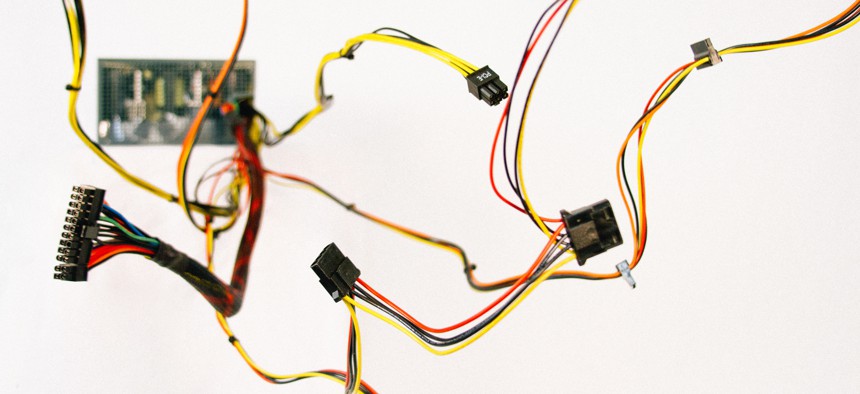
Randall Bruder/Unsplash
3 Predictions for Government Tech in 2018
Here's which tech will move from buzzword to implementation.
May I be the first to wish you a Happy New Year? For me anyway, 2017 seemed to fly by in the blink of an eye. I almost can’t believe it’s late December and we are about to put this one into the books. The pending start of a new year means that it’s prediction season once again, where pundits and columnists make their calls about what they expect to see in the coming year. And unlike most others, I actually go back over my work and fact check everything at the end of each year, so I need to be careful with my predictions. Thankfully, I got more right than wrong in 2017, although the ratio was closer than I would have liked.
Past performance aside, I’m feeling pretty good about my 2018 predictions for technology and government.
Prediction 1: Blockchain Beefs Up Government Cybersecurity
Originally created in 2009 to secure the emerging Bitcoin cryptocurrency, blockchain has lately been examined as a possible way to secure transactions, documents and messaging for a variety of applications in many sectors. Now the government is doing its own experiments in this area. Part of the National Defense Authorization Act of 2018, signed earlier this month by President Donald Trump, directs the Defense Department to conduct a comprehensive study of blockchain technology to find out where it can be successfully deployed in government.
Defense will quickly learn the value of this innovative technology, which was also the subject of many books and publications released this year. There is even a Dummies Guide for it, so the mainstream is catching on. What Defense will learn about blockchain is that it was originally created as a sort of digital register, but one that gives power to every previous record holder to approve, or at least know about, all future transactions or changes.
Each record, or block, within a blockchain is protected by encryption. As the record changes hands, new blocks are created that point back to the previous records within the chain. And once recorded, no data can be changed or altered without going back and modifying every subsequent block—a process that normally requires permission from all previous record holders. The interesting thing about blockchain is that it does not require a centralized server to make those transactions. It’s truly a distributed computing platform, which makes it even more secure because there is no central server to attack or compromise.
Defense may want to modify blockchain, adding a central server for example, and using it for secure messaging or protecting their supply chain. So blockchain in the military might look a bit different than in the private sector, but make no mistake, the technology will begin to see widespread use. It’s too good not to employ in a cybersecurity role.
Prediction 2: Artificial Intelligence Goes Mainstream
The days of worrying about artificial intelligence destroying the world are over. People are now starting to see AI for what it is, a useful form of computer technology that can supplement human tasks and abilities. People are also starting to see that using AI as a catchall term is misleading. Under the AI umbrella are technologies like cognitive computing, deep learning and machine learning, all of which do something slightly different than a pure artificial intelligence. It is these sub-technologies, still thought of as artificial intelligence, which will gain prominence in 2018.
Take deep learning as an example. In deep learning, data is shifted through successive layers of neural networks, with each one modifying the data based on its experiences and programming. This more or less mimics the way that the human brain works, except that a properly outfitted computer can shift through millions of calculations per second. Yet, it only feeds data through the system that humans tell it to, so there is no danger of the computer thinking for itself.
The Defense Advanced Research Projects Agency is already experimenting with deep learning through their Deep Purposeful Learning program, which they call Deep Purple. And the National Institute of Mental Health is using the technology to help other AI programs explain predictions and conclusions. The idea there is to use artificial intelligence to help with patient care, and then use deep learning to explain any conclusions or prescriptions it makes to human doctors for verification.
And all of these efforts could be aided in 2018 by the invention of the TrueNorth chip by the Air Force Research Laboratory. TrueNorth is the first neuromorphic chip designed to mimic the human brain’s architecture, which can perform millions of calculations for very little power expenditure. Equipping a deep learning system with a chip specifically designed to support it could rapidly accelerate the growth of AI.
Prediction 3: Drones Become a Part of Everyday Life
While I don’t think Amazon will be delivering packages to me using a drone in 2018, which I think would be amazing, I do believe that drones will make serious inroads into our lives next year.
We have already started to see some impressive uses of drones in public safety roles, including some amazing rescues. There is every reason to believe that this will continue. And we also saw some very public, but questionable uses for drones this year, such as an organization using drones to harass homeless people hanging out around their offices in San Francisco.
Advances in drones in 2018 will be prolific, though perhaps not so noticeable, thanks to a natural synergy with the technologies being deployed in prediction two.
Most drones today rely on human operators to control and fly them, but also on humans to analyze whatever data a drone collects. An inspector could fly a drone out to check an oil well or power substation, but they would have to watch the feed and analyze the results either on the fly or later if the video is recorded.
New technology is helping to eliminate that last requirement, letting machines analyze the data gathered from drones, and greatly improving their value to organizations. A notable example of this is the Federal Aviation Administration’s partnership with BSFN Railway, the second largest freight railroad network in North America, on Project Pathway. The project deploys long-range drones to fly autonomously along 32,500 miles of track, taking video that is then automatically analyzed by computers to look for flaws or track problems.
With Project Pathway already reporting early successes, it can act as a model for autonomous drone use in other areas and industries, and could even have military applications. Given all this, it’s a safe bet that drones will be flying in a lot more places in 2018, whether you notice them or not.




